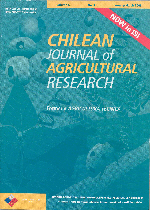
|
Agricultura Técnica
Instituto de Investigaciones Agropecuarias, INIA
ISSN: 0365-2807
EISSN: 0365-2807
Vol. 60, No. 3, 2000, pp. 224-235
|
 Bioline Code: at00020
Bioline Code: at00020
Full paper language: Spanish
Document type: Research Article
Document available free of charge
|
|
|
Agricultura Técnica, Vol. 60, No. 3, 2000, pp. 224-235
| en |
Characterization of the Growth and Production of Winter Forage Cereals in Córdoba, Argentina
Pagliaricci, H.R.; González, S.; Ohanian, A.E. & Pereyra, T.W.
Abstract
An experiment was conducted to characterize the growth and production of species and cultivars of winter forages widely used in the region. The species used were: rye (Secale cereale L.) cv. "Manfredi Suquía INTA" and "Naicó INTA"; oats (Avena sativa L.) cv. "Buck Tambera" and "Millauquén INTA", and triticale (x Triticosecale Wittmack) cv. "Tehuelche INTA", "Quiñé UNRC", "Genú UNRC", and "Tizné UNRC". The evaluation was carried out for four years (1993-96) with sowing during the first fortnight of March at densities that varied from 150 to 180 plants m-2. The measurements were made by monthly sampling leaving 7-10 cm stubble. The experimental design allowed the quantification of forage accumulated from sowing to the end of the cycle, and the re-growth occurring with different dates of first cut (50 or 79 days from sowing date). The phenological state of anthesis was considered for all entries as the moment of maximum accumulation. Dry matter accumulated during the growing period of plants without defoliation and that obtained with different first cut dates was estimated adjusting experimental values. The regression coefficients obtained and the acceptable degree of significance in most of the analyzed situations, suggest that the method offers the possibility of performing a good characterization of resources useful for comparison and, in this case in particular, to highlight the outstanding characteristics of each variety while trying to minimize costs.
Keywords
cereals, winter forage, growth curves, yield
|
| |
| es |
Caracterización del Crecimiento y la Producción de Cereales Forrajeros Invernales en Córdoba, Argentina
Pagliaricci, H.R.; González, S.; Ohanian, A.E. & Pereyra, T.W.
Resumen
Se condujo un experimento con el objeto de caracterizar el crecimiento y la producción de las especies y variedades de forrajes de invierno más difundidas en la región. Las especies utilizadas fueron: centeno (Secale cereale L.) cvs. "Manfredi Suquía INTA" y "Naicó INTA" ; avena (Avena sativa L.) cvs. "Buck Tambera" y "Millauquén INTA" y triticale (X Triticosecale Wittmack) cvs. "Tehuelche INTA", "Quiñé UNRC", "Genú UNRC" y "Tizné UNRC". La evaluación se efectuó durante cuatro años (1993 - 1996) con siembras efectuadas durante la primera quincena del mes de marzo y densidades que oscilaron entre 150 a 180 plantas m-2. Las mediciones se realizaron mediante muestreos mensuales dejando un remanente de 7 a 10 cm. La disposición del ensayo permitió medir el forraje acumulado desde la siembra hasta finalizar el ciclo y el crecimiento producido por los rebrotes con distintas fechas de primer corte (50 y 79 días desde la siembra). El estado fenológico de antesis fue considerado para todos los participantes como el momento de máxima acumulación. La materia seca acumulada durante el período de crecimiento de plantas sin defoliar y la obtenida con distintos momentos de primer corte fue estimada ajustando los valores experimentales. Los coeficientes de regresión obtenidos y el grado de significancia en la mayoría de las situaciones analizadas, permite afirmar que el método ofrece la posibilidad de realizar una buena caracterización de los recursos evaluados con fines de comparación, y en este caso en particular, destacar las características sobresalientes de cada una de las variedades y tratar de minimizar la incidencia de los costos.
Palabras-clave
cereales forrajeros de invierno, curvas de crecimiento, producción
|
| |
© Copyright 2000 - Instituto de Investigaciones Agropecuarias, INIA (Chile)
Alternative site location: http://www.inia.cl/at/agritec.htm
|
|
